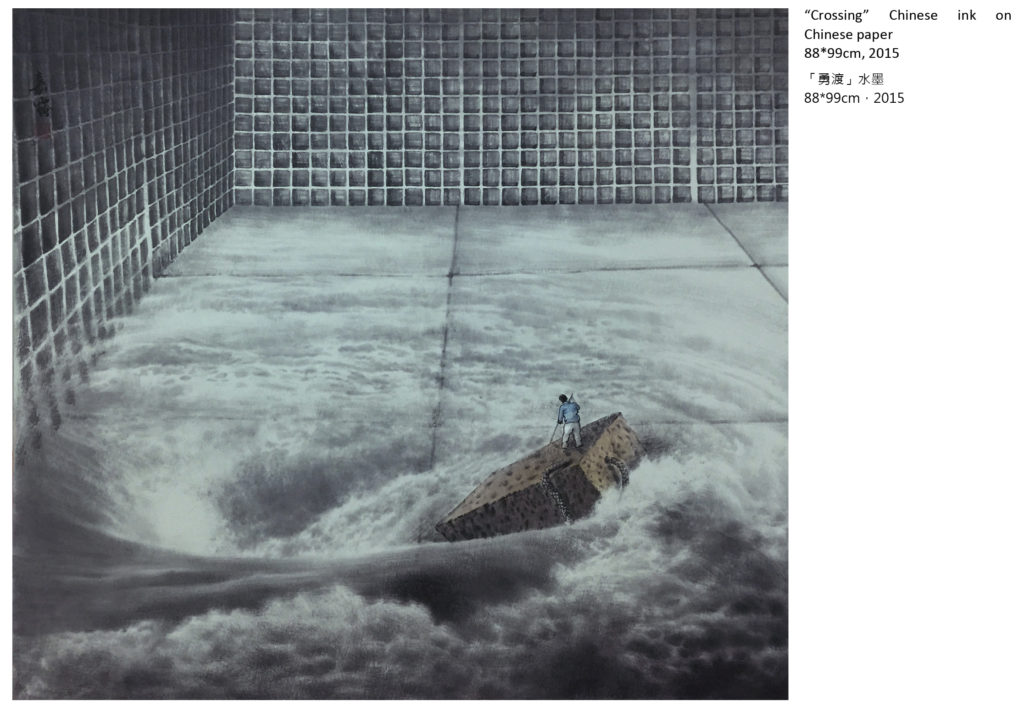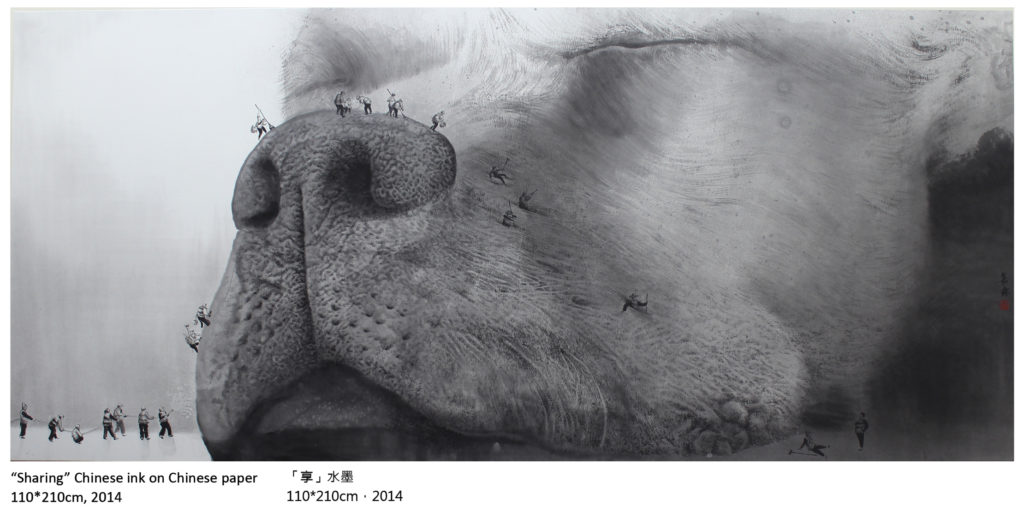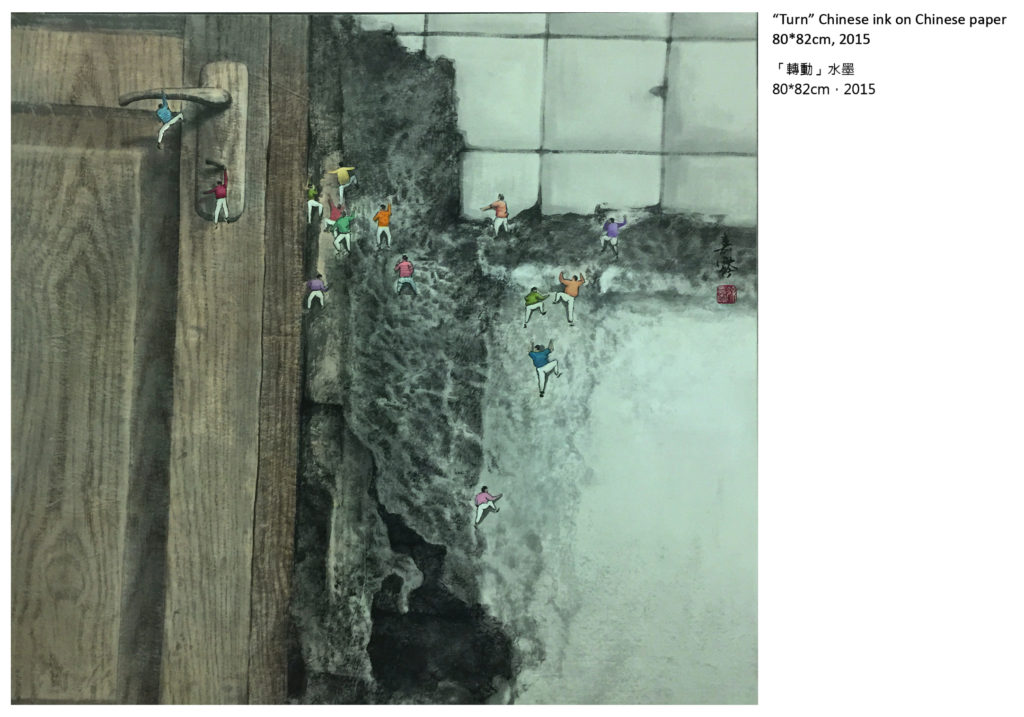Chinese ink art has a unique cultural significance in Chinese art history.
In recent years, “contemporary ink art” becomes a popular topic and receives high reputation around the globe. In a number of important international art fairs and exhibitions, we find contemporary ink artworks serve as the bridge of traditional Chinese culture and Western contemporary art history; they are interpreted from the Western perspective, presenting not only exquisite graphics but also three-dimensional installations, high tech videos and even behavior performances.
In 1996, Guggenheim Museum presented “China: 5000 Years”1 . This was the very first time that Chinese artworks were showcased at a large scale in a prestige Western museum. In 2012, British Museum gave us the exhibition of “Modern Chinese Ink Painting”2 ; and then in 2014, The Metropolitan Museum of Art launched a major Chinese art exhibition called the “Ink Art: The Past as Present in Contemporary China”3 . Moving from museums to market observation, Michael Goedhuis, who is a well-known art broker specializing in Chinese oil paintings, curated “Ink: The New Ink Art from China”4 for Saatchi Gallery in 2012. Several art pieces later on were exhibited and sold at the luxury fair, Masterpiece London. In 2013, both Sotheby’s and Christie’s held private selling exhibitions in New York, focusing on Chinese ink art, called “Shuimo / Water Ink: Chinese Contemporary ink Paintings – a selling Exhibition”5 and “Beyond Tradition: Chinese Contemporary ink”6, respectively. Sales generated from the above three commercial exhibitions turned out satisfying. At the end of last year (2015), the first international art fair focusing on Chinese ink art was born in Hong Kong – “Ink Asia”7 took place at Hong Kong Convention Center, more than 40 exhibitors from China, Hong Kong, Taiwan and so on. Types of visual art in this fair included all kinds, such as paintings, photographs, prints, ceramics, videos and installations. The phenomenon elaborates that contemporary ink art is no longer limited by brushes and papers; furthermore, it liberates contemporary art mediums, categories, and concepts and walks hand in hand with the digital world.
The emergence of “contemporary ink art” after the introduction of Western contemporary art reflects a pursuit of “modern” innovations inside Chinese art creation and somehow represents the direction of development and trend of Chinese ink art – going global.
Chinese contemporary ink in the new century presents the “urbanization” of the 80s Chinese society with escalating economic development, which indicates that Chinese ink art has stepped into the modern way from the traditional literati life style. Both creativity and anxiety in the modern society are delivered to a piece of work through artistic language. After the 1990s, contemporary ink art has been in constant dialogue with cultural and intellectual trends and also with Western contemporary art. All of the talks with the vitality inside the state of ink art contribute to the following movements such as experimental ink, new literati painting, new academic art, new ink, and so forth.
Ink art continues to evolve and achieves a peak performance in the mid-20th century. Chinese ink art in the 20th century is a period of reform and innovation, one after another to create a master course; it is an introspection and development process of Chinese ink art on the way to embrace the modern world. Whether it is due to the Chinese culture, internal self-transformation, or is it for a large number of response to the impacts and influences of the Western thoughts, the development of ink art, with no doubt, have had a fairly dramatic change in skill, concept or aesthetic ideology. The artworks present more than art styles; they reflect the contradiction, selection, and decision that the artists of this era face and deal with the environmental changes.
For examples: After absorbing numerous Western moulding concept and observation method, portrait painting revives by breaking through soft and extravagant style of the late Qing Dynasty. Representative is Xu Beihong and Jiang Zhaohe marks a new page in the annals. Huang Binhong in landscape painting inherits traditional spirits and explores experimental abstract skills at the same time. Qi Baishi simplifies lines in bird-and-flower paintings and advocates “paintings must be something between likeness and unlikeness”. Lin Fengmian opens up the road to color ink with modernist poetic language. Zhang Daqian, in his middle age working on landscape paintings, explores the spontaneity of ink by experimenting with methods of splashing, dripping, and rubbing. For those trying to make changes on subjects and themes, the artists integrate the new-found cutting-edge art influence from Western world with traditional Chinese culture to bring out richer and stronger person-al attitude in their creations.
Three essences of ink art: line, ink tone and relation between solids and voids.
Line is one of the basic essence of ink painting. Simple lines complete the ideal form and live movement in most of the traditional ink paintings. Line is a very powerful vehicle for visual expression; the outline gives an object meaning and also implies what is “to be seen” and “not to be seen”.
Ink tone is the second essential element of ink painting. Ink tone is to highlight the lines, to increase the sense of space and volume, to heighten the poetic effect and to create imaginative space. Ink not only enhances the sense of space, but also substitutes for color. The ancients had a saying: When we have ink, it means that we have five colors. The amount of ink determines plasticity and atmosphere of the artwork. After rendering in ink, the diffusion effect transfers aesthetic appreciation onto the paper and brings objects to life.
Relation between solids and voids is the third element. Objects express the theme and topic of the work, but the white space implies the mystery in emptiness. Voids, by suggesting an association between non presence and the openness of the virtual imagination, creates the depth of a picture. Such as ink paintings in the Song Dynasty, the vastness of landscape was not conveyed by a multitude of solids, but by the quality of the voids.
Three essences of contemporary ink art: abstract quality, poetic effect, and plasticity of personal style.
One of elements of contemporary significance is the abstract quality of ink painting. In today’s urban society, lines and ink tone retain their expressive power, and, with abstracting process involved in the creation, are able to address the complex manifestations of contemporary life.
The second element of contemporary significance is poetic vision. The combination of lines and ink tone, solids and voids creates a special dynamic vitality, not only in the way in which it brings out the characteristic features of objects, but also gives virtual imagination. Going beyond the real object, we might call it a picture in a poem, and a poem in a picture.
The third element of contemporary significance is plasticity of personal style. How the artists respond to the essences of ink art, lines, ink tone, and relation between solids and voids, leads them to form their own style and create rich emotional and personal aesthetic.
When traditions meet globalization, contemporary ink art in the 21st century is undoubtedly considered a broad extension of the concept of Chinese ink paintings. Contemporary ink art covers the conversion and transformation of traditional and modern ideas and techniques of ink performance. Contemporary ink art retrieves Oriental spirit with injection of Western concept of contemporary art. In addition, contemporary ink art can be entirely experimental, or can be beyond the paper, such as three-dimensional or large installations. Contemporary ink art is writing a new chapter in the Chinese ink art history with the creativity and synergistic effect of different mediums.
——————————————————–
1 “China: 5000 Years” by Guggenheim Museum: http://www.guggenheim.org/new-york/exhibitions/publications/from-the-archives/items/view/171
2 “Modern Chinese Ink Painting” by British Museum: http://www.britishmuseum.org/whats_on/past_exhibitions/2012/chinese_ink_paintings.aspx
3 “Ink Art: The Past as Present in Contemporary China” by Metropolitan Museum: http://www.metmuseum.org/exhibitions/listings/2013/ink-art
4 “Ink: The New Ink Art from China” by Michael Goedhuis at Saatchi Gallery: http://www.michaelgoedhuis.com/DesktopDefault.aspx?tabid=47&tabindex=46&eventid=20177
5 Sotheby’s “Shuimo / Water Ink: Chinese Contemporary ink Paintings – a selling Exhibition”: http://www.sothebys.com/en/auctions/2013/chinese-contemporary-ink-n09023.html
6 Christie’s “Beyond Tradition: Chinese Contemporary ink”: http://www.christies.com/features/beyond-tradition-chinese-contemporary-ink-3411-3.aspx
7 “Ink Asia”: http://www.inkasia.com.hk/







Be the first to comment